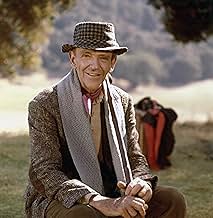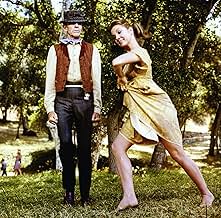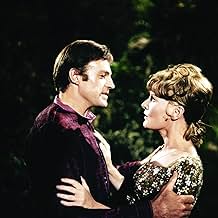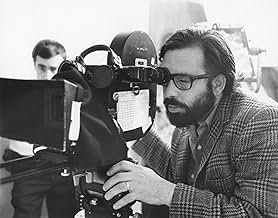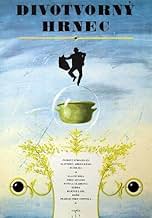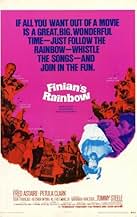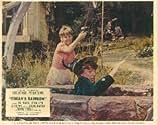VALUTAZIONE IMDb
6,1/10
4463
LA TUA VALUTAZIONE
Aggiungi una trama nella tua linguaAn Irish immigrant and his daughter move into a town in the American South with a magical piece of gold that will change people's lives, including a struggling farmer and African American ci... Leggi tuttoAn Irish immigrant and his daughter move into a town in the American South with a magical piece of gold that will change people's lives, including a struggling farmer and African American citizens threatened by a bigoted politician.An Irish immigrant and his daughter move into a town in the American South with a magical piece of gold that will change people's lives, including a struggling farmer and African American citizens threatened by a bigoted politician.
- Regia
- Sceneggiatura
- Star
- Candidato a 2 Oscar
- 1 vittoria e 9 candidature totali
Brenda Arnau
- Sharecropper 'Necessity'
- (non citato nei titoli originali)
Charles Carter
- Sharecropper
- (non citato nei titoli originali)
Sterling Clark
- Sharecropper
- (non citato nei titoli originali)
Robert Cleaves
- Geologist
- (non citato nei titoli originali)
Robert Cole
- Sharecropper
- (non citato nei titoli originali)
Willie Covan
- Sharecropper
- (non citato nei titoli originali)
Evelyn Dutton
- Sharecropper
- (non citato nei titoli originali)
Recensioni in evidenza
I remember seeing this film when it was first released. I absolutely hated it - too slow-moving, and the male romantic lead was a cipher. Even the songs were manipulated to the point that I could barely stand to listen to them. Tommy Steele was far too frenetic as Og, the leprechaun. Its saving graces were Fred Astaire, Petula Clark (although she seemed too old in the role of Sharon), and Keenan Wynn. I've avoided it like the plague ever since.
Tonight, thanks to Turner Classic Movies, I finally watched it again. And you know what? It's a lot better than I remembered. I don't know what has caused the turnabout in my opinion, except perhaps the lack of quality of most of the musical films that have come along since FINIAN'S RAINBOW in 1968. It still has a few longueurs, but generally it's very enjoyable. Even Tommy Steele isn't too bad. Don Francks is still dramatically stiff, but he's better than I remembered, and he sings well. And oh, those songs! It's a shame that "Necessity" was cut, but otherwise, what a string of melody - How are Things in Glocca Morra, Old Devil Moon, When I'm not Near the Girl I Love, and more.
Thank you, TCM, for giving me a second chance with this film!
Tonight, thanks to Turner Classic Movies, I finally watched it again. And you know what? It's a lot better than I remembered. I don't know what has caused the turnabout in my opinion, except perhaps the lack of quality of most of the musical films that have come along since FINIAN'S RAINBOW in 1968. It still has a few longueurs, but generally it's very enjoyable. Even Tommy Steele isn't too bad. Don Francks is still dramatically stiff, but he's better than I remembered, and he sings well. And oh, those songs! It's a shame that "Necessity" was cut, but otherwise, what a string of melody - How are Things in Glocca Morra, Old Devil Moon, When I'm not Near the Girl I Love, and more.
Thank you, TCM, for giving me a second chance with this film!
Whimsical is not a word I get to use often, but that's exactly what Finian's Rainbow is. Based on the 1947 stage musical it's part fantasy and part political satire. The plot follows the quintessential Irishman Finian(Fred Astaire in his last full screen role) and his daughter Sharon (Petula Clark) as they basically flee to America with a pot of gold stolen from the leprechaun, Og (Tommy Steele). After an amazing opening credit sequence ("Look To The Rainbow"), they arrive in "Misitucky" which is supposed to be near Fort Knox, to bury the gold in the belief that it will multiply. The small hamlet of Rainbow Valley becomes their home, a kind of Tobacco Road with very poor but very happy hippie-like inhabitants. Here Sharon meets her love interest Woody (Don Francks) Add Keenan Wynn as the villain, Senator Hawkins, a racist Southern stereotype that during the course of the story turns black. Several minor plots weave in and out, creating a rich and unique film. Astaire used to sound stages and carefully planned dance numbers balked at dancing outside in a field and the director, Francis Ford Coppola (an odd choice, but what's done is done) tried his best to meet his demands. Ironically the field sequence, which comes early in the film is beautiful and very well done by the choreographer Hermes Pan, who was subsequently fired from the film. Petula Clark clearly steals the movie. The camera loves her in this and her natural beauty and performance are such a pleasure to watch. Astaire, who was criticized cruelly for his appearance (he was 69 at the time) is as usual charming and no one danced like he did. Francks holds his own and makes a nice compliment to Clark. Tommy Steele's performance rolics between delightful and way too over the top. Beautifully filmed, it does suffer from jarring "this is real, this is fake" scenery but if you just go with it, it's not that bad. The DVD presents Astaire's dance numbers complete and full body (something Astaire always insisted on but was overlooked in the original release) Finian's Rainbow is known now more for many of it's songs than itself as a whole, but it's still very much worth a look, especially if you love musicals.
I love musicals and have done for the longest time. Finian's Rainbow is not among the best of the film musicals, but it is hardly among the worst either. It does have a ridiculous story and some moments of awkward editing. That said, it is definitely worth watching and is for me Francis Ford-Coppola's most underrated film.
The editing aside, I like the production values a lot, as the sets and costumes are lovely and there is some good lighting. The score and songs are all wonderful, my least favourite The Begat is still very good, and Old Devil Moon, When the Idle Poor Became the Idle Rich and particularly Look to the Rainbow are timeless.
Coppola directs with assurance, the choreography is some of the best I've seen in a while and the script has a lot of funny, witty and heart warming parts. When it comes to favourite scenes, the Rain Dance Ballet, which is lovingly choreographed, and the scene where Al Freeman Jnr applies for the job of butler, which is hilarious, are the most memorable to me.
I can't fault the cast either, Fred Astaire can do no wrong in my eyes, Tommy Steele and Al Freeman Jnr steal every scene they're in and I don't think there is another film where Petula Clark is more perfectly cast. In conclusion, flawed but definitely worth the watch. 8/10 Bethany Cox
The editing aside, I like the production values a lot, as the sets and costumes are lovely and there is some good lighting. The score and songs are all wonderful, my least favourite The Begat is still very good, and Old Devil Moon, When the Idle Poor Became the Idle Rich and particularly Look to the Rainbow are timeless.
Coppola directs with assurance, the choreography is some of the best I've seen in a while and the script has a lot of funny, witty and heart warming parts. When it comes to favourite scenes, the Rain Dance Ballet, which is lovingly choreographed, and the scene where Al Freeman Jnr applies for the job of butler, which is hilarious, are the most memorable to me.
I can't fault the cast either, Fred Astaire can do no wrong in my eyes, Tommy Steele and Al Freeman Jnr steal every scene they're in and I don't think there is another film where Petula Clark is more perfectly cast. In conclusion, flawed but definitely worth the watch. 8/10 Bethany Cox
This was Fred Astaire's last full-blown musical movie ("That's Entertainment II" is not counted). The original play, written back in the 1930's, dealt more with the organization of a union by a bunch of poor sharecroppers. But by the time this movie was finally set to be made, unions were no longer the "hot topic", thus the racism angle was embellished. Plot aside, which isn't difficult, the basis of the story is that Finian McGlonnagen (Fred Astaire) has stolen a pot of gold from Og the leprechaun (played to perfection by Tommy Steele) and has plans to bury it near Fort Knox, thinking that the "magical properties" in the ground there will make more gold for him. Not exactly Pulitzer stuff here, but an enjoyable movie. A great vehicle for Keenan Wynn, showing why he was the best character actor of his day, and Tommy Steele, who disappeared from American movie screens far too soon. Great music; Good movie.
Opening on Broadway in 1947 with music by Burton Lane and lyrics by E.Y. "Yip" Harburg (who wrote the lyrics for 1939's THE WIZARD OF OZ), FINIAN'S RAINBOW was an unexpected smash that generated one pop classic after another--"How Are Things In Glocca Morra?," "Old Devil Moon," and "Look To The Rainbow" to name but three. But when talk turned to a film version, not a single studio in Hollywood would touch it: although the story was fantasy, it was also extremely satirical, contained elements that had a decidedly socialist edge, and made one of the most wickedly funny statements on racism seen up to that time. With Hollywood operating under the production code and the nation drifting into the communist paranoia of the 1950s, the whole thing was impossibly hot. And so FINIAN'S RAINBOW remained off the screen for over twenty years... until 1968, when a sudden splash of popular screen musicals prompted Warner Brothers to bankroll it.
The plot is deliberately ridiculous, and finds Irishman Finian McLonergan (Fred Astaire) and his long suffering daughter Sharon (Petula Clark) in Tennessee, where Finian plans to bury a crock of gold stolen from a leprechaun (Tommy Steele) on the theory that the land around Fort Knox will make the gold grow. But things take an unexpected turn when they arrive in Rainbow Valley, where they encounter a commune of black and white tobacco sharecroppers doing battle with a viciously bigoted Senator (Keenan Wynn.) And when daughter Sharon is outraged by the Senator's racism and happens to be standing by the hidden crock of gold--she accidentally "wishes" the Senator black! Unlike the 1947 stage show, the big screen version of FINIAN'S RAINBOW tanked at the box office, and it is little wonder: both producers and then-novice director Francis Ford Coppola made a host of very basic mistakes with the material, the first of which was not keeping the film within its original 1940s context; they instead give it a 'contemporary' tone that not only undercuts the fanciful storyline but makes many of the story's elements seem heavy-handed. In the process they manage to blunt the edge of the original in a very significant sort of way. There are also a number of cinematic problems with the movie, which feels awkwardly filmed and still more awkwardly edited, and the film visibly shifts between outdoor set-ups and studio soundstage sets in a very uncomfortable sort of way.
All of that said, there is still a great deal to enjoy in FINIAN'S RAINBOW--the aforementioned score for one and the truly memorable performances for another. Astaire is timeless, Tommy Steele almost walks away with the show, Keegan Wynn (in spite of some rather ill-advised make-up) gives a memorable performance as the bigoted Senator, and Al Freeman Jr. is absolutely hilarious in the sequence where he applies for the job of butler in the Senator's home--I laugh just thinking about it! But the real revelation here is Petula Clark. Best known as a pop singer, Clark is perfection as Sharon McLonergan; it is a tremendous pity that she was never again so well-cast on screen. And together they manage to gloss over most of the film's weaknesses; if you're a musical fan, you're likely to enjoy it.
Gary F. Taylor, aka GFT, Amazon Reviewer
The plot is deliberately ridiculous, and finds Irishman Finian McLonergan (Fred Astaire) and his long suffering daughter Sharon (Petula Clark) in Tennessee, where Finian plans to bury a crock of gold stolen from a leprechaun (Tommy Steele) on the theory that the land around Fort Knox will make the gold grow. But things take an unexpected turn when they arrive in Rainbow Valley, where they encounter a commune of black and white tobacco sharecroppers doing battle with a viciously bigoted Senator (Keenan Wynn.) And when daughter Sharon is outraged by the Senator's racism and happens to be standing by the hidden crock of gold--she accidentally "wishes" the Senator black! Unlike the 1947 stage show, the big screen version of FINIAN'S RAINBOW tanked at the box office, and it is little wonder: both producers and then-novice director Francis Ford Coppola made a host of very basic mistakes with the material, the first of which was not keeping the film within its original 1940s context; they instead give it a 'contemporary' tone that not only undercuts the fanciful storyline but makes many of the story's elements seem heavy-handed. In the process they manage to blunt the edge of the original in a very significant sort of way. There are also a number of cinematic problems with the movie, which feels awkwardly filmed and still more awkwardly edited, and the film visibly shifts between outdoor set-ups and studio soundstage sets in a very uncomfortable sort of way.
All of that said, there is still a great deal to enjoy in FINIAN'S RAINBOW--the aforementioned score for one and the truly memorable performances for another. Astaire is timeless, Tommy Steele almost walks away with the show, Keegan Wynn (in spite of some rather ill-advised make-up) gives a memorable performance as the bigoted Senator, and Al Freeman Jr. is absolutely hilarious in the sequence where he applies for the job of butler in the Senator's home--I laugh just thinking about it! But the real revelation here is Petula Clark. Best known as a pop singer, Clark is perfection as Sharon McLonergan; it is a tremendous pity that she was never again so well-cast on screen. And together they manage to gloss over most of the film's weaknesses; if you're a musical fan, you're likely to enjoy it.
Gary F. Taylor, aka GFT, Amazon Reviewer
Lo sapevi?
- QuizMany, including Fred Astaire, blamed director Francis Ford Coppola for cutting off Astaire's feet during filming of his dancing scenes, but it was Warner Bros. who decided, after the filming had been completed in 35mm, to convert the film to the wider 70mm and promote it as a "reserved-ticket roadshow attraction." This was achieved by cropping off the tops and bottoms of the film frame, including some shots of Astaire's footwork.
- BlooperIn the song "Old Devil Moon" as Woody and Sharon dance through the stream, Woody has bare feet and his hands are in Sharon's. In the next shot, he has his shoes on, and it even looks as if his trousers are dry.
- Versioni alternativeFilmed in 35mm, Warners decided afterwards to promote it as a "reserved-ticket roadshow attraction" and converted it to 70mm, creating a wider-screen aspect ratio by cropping away the tops and bottoms of the images, and cropping away Fred Astaire's feet during some of his dance scenes. Restored versions show the original aspect ratio.
- ConnessioniEdited into The Kid Stays in the Picture (2002)
- Colonne sonoreLook To The Rainbow / How Are Things In Glocca Morra?
(1946) (uncredited)
(Main Title)
Played during the opening credits
Lyrics by E.Y. Harburg
Music by Burton Lane
Sung by Petula Clark ("Rainbow") and played by the Warner Bros.
Orchestra ("Glocca Morra") conducted by Ray Heindorf
I più visti
Accedi per valutare e creare un elenco di titoli salvati per ottenere consigli personalizzati
- How long is Finian's Rainbow?Powered by Alexa
Dettagli
Botteghino
- Budget
- 3.500.000 USD (previsto)
- Tempo di esecuzione2 ore 21 minuti
- Proporzioni
- 2.39 : 1
Contribuisci a questa pagina
Suggerisci una modifica o aggiungi i contenuti mancanti


